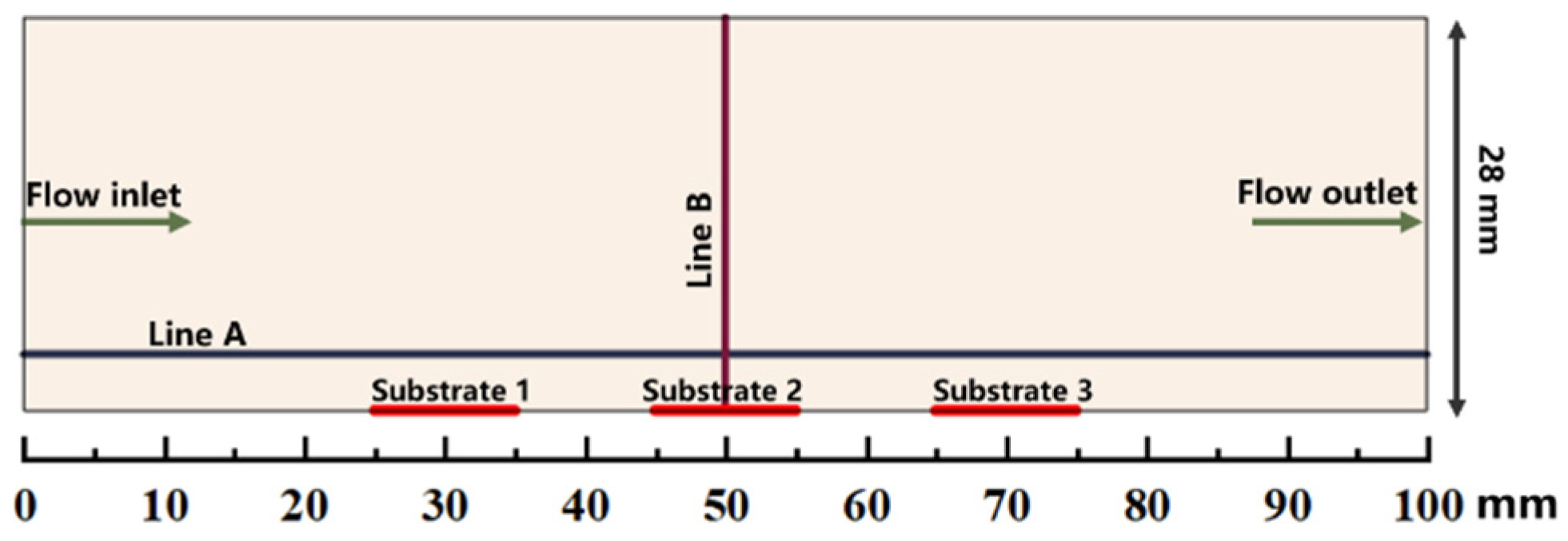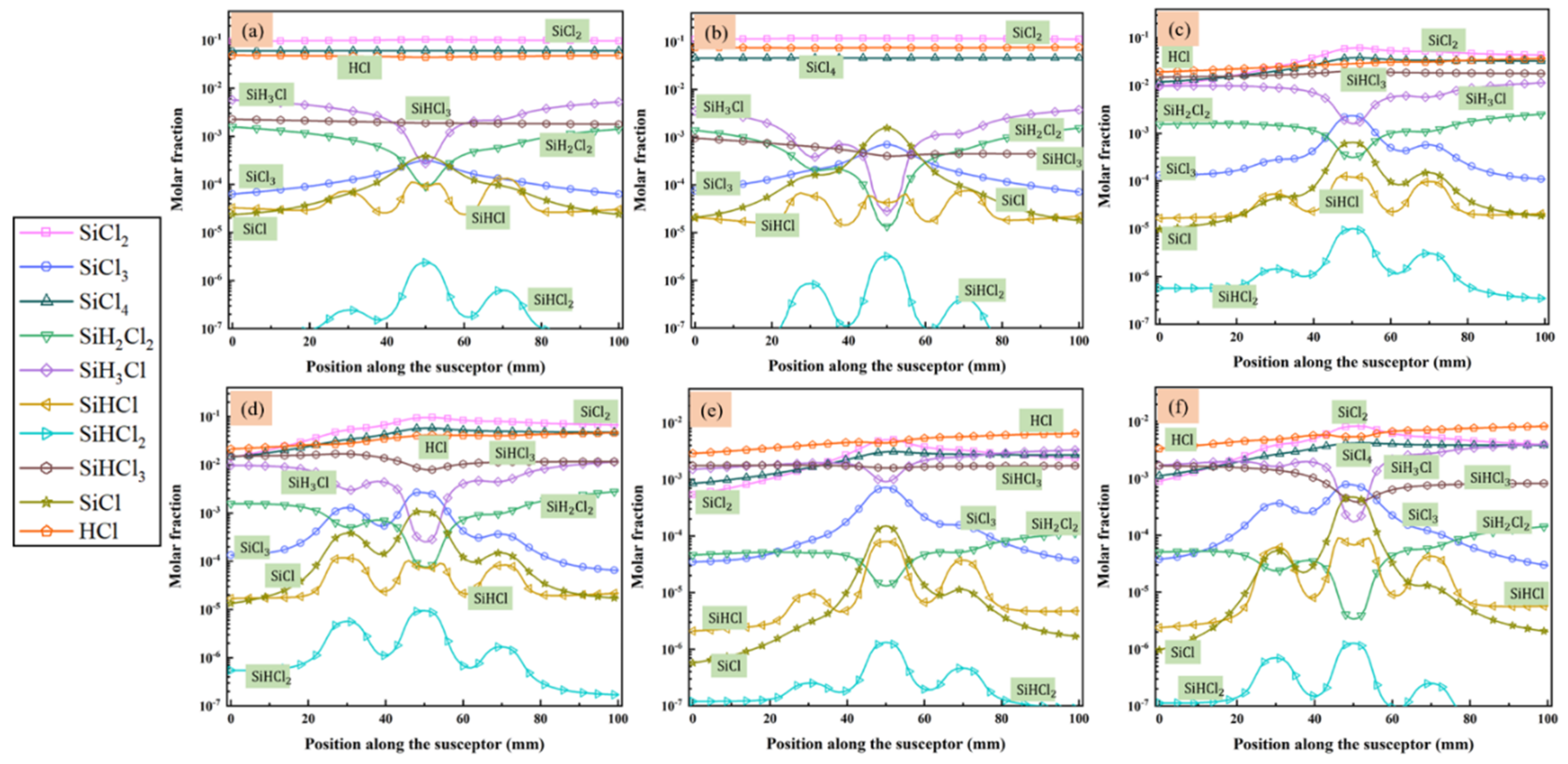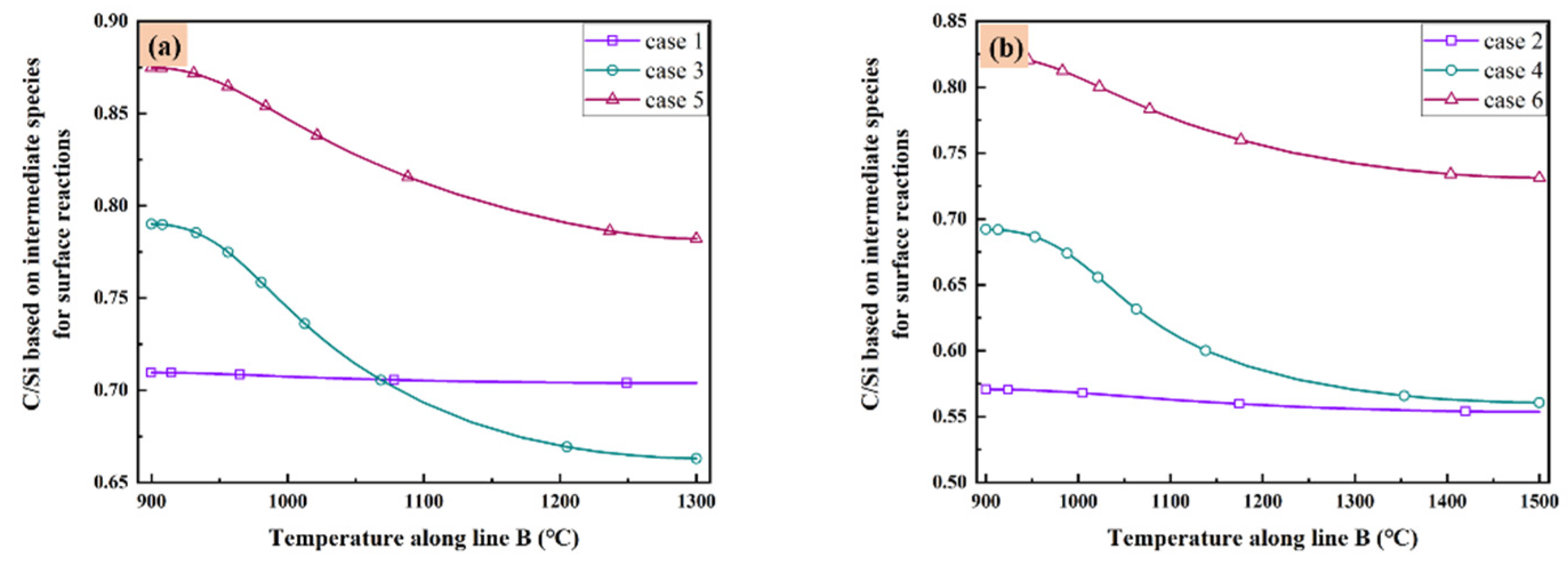Numerical Simulation of Gas Phase Reaction for Epitaxial Chemical Vapor Deposition of Silicon Carbide by Methyltrichlorosilane in Horizontal Hot-Wall Reactor
Abstract
:1. Introduction
2. Simulation Modeling
3. Results and Discussion
4. Conclusions
Author Contributions
Funding
Institutional Review Board Statement
Informed Consent Statement
Data Availability Statement
Conflicts of Interest
References
- Allendorf, M.D.; Kee, R.J. A model of silicon-carbide chemical vapor-deposition. J. Electrochem. Soc. 1991, 138, 841–852. [Google Scholar] [CrossRef]
- Powell, J.A.; Will, H.A. Epitaxial growth of 6H SiC in the temperature range 1320–1390 °C. J. Appl. Phys. 1973, 44, 5177–5178. [Google Scholar] [CrossRef]
- Fiorucci, A.; Moscatelli, D.; Masi, M. Homoepitaxial silicon carbide deposition processes via chlorine routes. Surf. Coat. Technol. 2007, 201, 8825–8829. [Google Scholar] [CrossRef]
- Kleijn, C.R. Computational modeling of transport phenomena and detailed chemistry in chemical vapor deposition—A benchmark solution. Thin Solid Film. 2000, 365, 294–306. [Google Scholar] [CrossRef]
- Danielsson, O.; Henry, A.; Janzen, E. Growth rate predictions of chemical vapor deposited silicon carbide epitaxial layers. J. Cryst. Growth. 2002, 243, 170–184. [Google Scholar] [CrossRef]
- Ji, W.; Lofgren, P.M.; Hallin, C.; Gu, C.Y.; Zhou, G. Computational modeling of SiC epitaxial growth in a hot wall reactor. J. Cryst.Growth 2000, 220, 560–571. [Google Scholar] [CrossRef]
- Lofgren, P.M.; Ji, W.; Hallin, C.; Gu, C.Y. Modeling of silicon carbide epitaxial growth in hot-wall chemical vapor deposition processes. J. Electrochem. Soc. 2000, 147, 164–175. [Google Scholar] [CrossRef]
- Danielsson, O.; Forsberg, U.; Henry, A.; Janzen, E. Investigation of the temperature profile in a hot-wall SiC chemical vapor deposition reactor. J. Cryst. Growth 2002, 235, 352–364. [Google Scholar] [CrossRef]
- Vorob’ev, A.N.; Egorov, Y.E.; Makarov, Y.N.; Zhmakin, A.I.; Galyukov, A.O.; Rupp, R. Modeling of silicon carbide chemical vapor deposition in a vertical reactor. Mat. Sci. Eng. B 1999, 61–62, 172–175. [Google Scholar] [CrossRef]
- Rupp, R.; Makarov, Y.N.; Behner, H.; Wiedenhofer, A. Silicon carbide epitaxy in a vertical CVD reactor: Experimental results and numerical process simulation. Phys. Status Solidi B 1997, 202, 281–304. [Google Scholar] [CrossRef]
- Vorob’ev, A.N.; Karpov, S.Y.; Bogdanov, M.V.; Komissarov, A.E.; Bord, O.V.; Zhmakin, A.I.; Makarov, Y.N. Numerical study of SiCCVD in a vertical cold-wall reactor. Comp. Mater. Sci. 2002, 24, 520–534. [Google Scholar] [CrossRef]
- Guan, K.; Gao, Y.; Zeng, Q.F.; Luan, X.G.; Zhang, Y.; Cheng, L.F.; Wu, J.Q.; Lu, Z.Y. Numerical modeling of SiC by low-pressure chemical vapor deposition from methyltrichlorosilane. Chin. J. Chem. Eng. 2020, 28, 1733–1743. [Google Scholar] [CrossRef]
- Masahara, K.; Takahashi, T.; Kushibe, M.; Ohno, T.; Nishio, J.; Kojima, K.; Ishida, Y.; Suzuki, T.; Tanaka, T.; Yoshida, S.; et al. High-rate epitaxial growth of 4H-SiC using a vertical-type, quasi-hot-wall CVD reactor. Mater. Sci. Forum 2002, 389–393, 179–182. [Google Scholar] [CrossRef]
- Kordina, O.; Hallin, C.; Henry, A.; Bergman, J.P.; Ivanov, I.; Ellison, A.; Son, N.T.; Janzen, E. Growth of SiC by “hot-wall” CVD and HTCVD. Phys. Status Solidi B 1997, 202, 321–334. [Google Scholar] [CrossRef]
- Ellison, A.; Zhang, J.; Magnusson, W.; Henry, A.; Wahab, Q.; Bergman, J.P.; Hemmingsson, C.; Son, N.T.; Janzen, E. Fast SiC epitaxial growth in a chimney CVD reactor and HTCVD crystal growth developments. Mater. Sci. Forum 2000, 338–342, 131–136. [Google Scholar] [CrossRef]
- Myers, R.L.; Shishkin, Y.; Kordina, O.; Saddow, S.E. High growth rates (>30 mu m/h) of 4H-SiC epitaxial layers using a horizontal hot-wall CVD reactor. J. Cryst. Growth 2005, 285, 486–490. [Google Scholar] [CrossRef]
- Guan, K.; Zeng, Q.; Liu, Y.; Luan, X.; Lu, Z.; Wu, J. A multiscale model for CVD growth of silicon carbide. Comp. Mater. Sci. 2021, 196, 110512. [Google Scholar] [CrossRef]
- Leone, S.; Kordina, O.; Henry, A.; Nishizawa, S.; Danielsson, O.; Janzen, E. Gas-phase modeling of chlorine-based chemical vapor deposition of silicon carbide. Cryst. Growth Des. 2012, 12, 1977–1984. [Google Scholar] [CrossRef]
- Meziere, J.; Ucar, M.; Blanquet, E.; Pons, M.; Ferret, P.; Di Cioccio, L. Modeling and simulation of SiC CVD in the horizontal hot-wall reactor concept. J. Cryst. Growth 2004, 267, 436–451. [Google Scholar] [CrossRef]
- Wang, R.; Ma, R.H.; Dudley, M. Reduction of chemical reaction mechanism for halide-assisted silicon carbide epitaxial film deposition. Ind. Eng. Chem. Res. 2009, 48, 3860–3866. [Google Scholar] [CrossRef]
- Nishizawa, S.; Pons, M. Growth and doping modeling of SiC-CVD in a horizontal hot-wall reactor. Chem Vap. Depos. 2006, 12, 516–522. [Google Scholar] [CrossRef]
- Pedersen, H.; Leone, S.; Kordina, O.; Henry, A.; Nishizawa, S.; Koshka, Y.; Janzen, E. Chloride-based cvd growth of silicon carbide for electronic applications. Chem. Rev. 2012, 112, 2434–2453. [Google Scholar] [CrossRef] [PubMed]
- Lu, C.Y.; Cheng, L.F.; Zhao, C.N.; Zhang, L.T.; Xu, Y.D. Kinetics of chemical vapor deposition of SiC from methyltrichlorosilane and hydrogen. Appl. Surf. Sci. 2009, 255, 7495–7499. [Google Scholar] [CrossRef]
- Cavallotti, C.; Rossi, F.; Ravasio, S.; Masi, M. A Kinetic analysis of the growth and doping kinetics of the SiC chemical vapor deposition process. Ind. Eng. Chem. Res. 2014, 53, 9076–9087. [Google Scholar] [CrossRef]
- Fukushima, Y.; Sato, N.; Funato, Y.; Sugiura, H.; Hotozuka, K.; Momose, T.; Shimogaki, Y. Multi-scale analysis and elementary reaction simulation of SiC-CVD using CH3SiCl3/H-2. ECS J. Solid State Sci. Technol. 2013, 2, P492. [Google Scholar] [CrossRef]
- Deivendran, B.; Shinde, V.M.; Kumar, H.; Prasad, N.E. 3D Modeling and optimization of SiC deposition from CH3SiCl3/H-2 in a commercial hot wall reactor. J. Cryst. Growth 2021, 554, 125944. [Google Scholar] [CrossRef]
- Mousavipour, S.H.; Saheb, V.; Ramezani, S. Kinetics and mechanism of pyrolysis of methyltrichlorosilane. J. Phys. Chem. A 2004, 108, 1946–1952. [Google Scholar] [CrossRef]
- Brokaw, R.S. Predicting transport properties of dilute gases. Ind. Eng. Chem. Process. Des. Dev. 1969, 8, 240–253. [Google Scholar] [CrossRef]
- Neufeld, P.D.; Janzen, A.R.; Aziz, R.A. Empirical equations to calculate 16 of the transport collision integrals Ω(l, s)* for the Lennard-Jones (12–6) potential. J. Chem. Phys. 1972, 57, 1100–1102. [Google Scholar] [CrossRef]
- Nishizawa, S.; Pons, M. Numerical modeling of SiC-CVD in a horizontal hot-wall reactor. Microelectron Eng. 2006, 83, 100–103. [Google Scholar] [CrossRef]
- Wang, R.; Ma, R.H. An integrated model for halide chemical vapor deposition of silicon carbide epitaxial films. J. Cryst. Growth 2008, 310, 4248–4255. [Google Scholar] [CrossRef]
- Wang, R.; Ma, R.H. Kinetics of halide chemical vapor deposition of silicon carbide film. J. Cryst. Growth 2007, 308, 189–197. [Google Scholar] [CrossRef]






| Substrate 1 Temp (°C) | Substrate 2 Temp (°C) | Substrate 3 Temp (°C) | H2 Flow (sccm) | MTS Flow (sccm) | Pressure (kPa) | |
|---|---|---|---|---|---|---|
| Case 1 | 1000 | 1300 | 1100 | 100 | 25 | 6 |
| Case 2 | 1200 | 1500 | 1100 | 100 | 25 | 6 |
| Case 3 | 1000 | 1300 | 1100 | 5000 | 1250 | 20 |
| Case 4 | 1200 | 1500 | 1100 | 5000 | 1250 | 20 |
| Case 5 | 1000 | 1300 | 1100 | 5000 | 75 | 20 |
| Case 6 | 1200 | 1500 | 1100 | 5000 | 75 | 20 |
| Reaction on Bulk Silicon Carbide Surface * | |
|---|---|
| SiHCl3 + 2Si($) + 2C($) → SiCl(S) + H(S) + 2ClSi(S) | SiCl4 + 2Si($) + 2C($) → SiCl(S) + ClC(S) + 2ClSi(S) |
| SiHCl3 + Si($) + 3C($) → SiCl(S) + H(S) + ClC(S) + ClSi(S) | SiH2Cl2 + Si($) + 3C($) → SiCl(S) + 2H(S) + ClSi(S) |
| SiH3Cl + 2C($) → SiCl(S) + H(S) + H2 | C2H6 + 2Si($) → 2C(S) + 3H2 |
| C2H4 + 2Si($) → 2C(S) + 2H2 | C2H3 + 2Si($) → C(S) + CH(S) + H2 |
| C2H2 + 2Si($) → 2C(S) + H2 | CH4 + Si($) → C(S) + 2H2 |
| SiCl3 + 2C($) + Si($) → SiCl(S) + ClC(S) + ClSi(S) | SiCl3 + C($) + 2Si($) → SiCl(S) + 2ClSi(S) |
| SiCl3 + 3C($) → SiCl(S) + 2ClC(S) | SiHCl + C($) → Si(S) + HCl |
| SiCl + C($) → SiCl(S) | 2ClC(S) + SiCl2 → SiCl4 + 2C($) |
| SiCl2 + 2C($) → SiCl(S) + ClC(S) | ClSi(S) + ClC(S) + SiCl2 → SiCl4 + Si($) + C($) |
| SiCl2 + Si($) + C($) → SiCl(S) + ClSi(S) |
| C Contained Species | Si Contained Species |
|---|---|
| C2H6, C2H4, C2H3, C2H3, CH4 | SiH3Cl, SiHCl3, SiH2Cl2, SiCl4, SiCl3, SiCl2, SiCl, SiHCl |
Publisher’s Note: MDPI stays neutral with regard to jurisdictional claims in published maps and institutional affiliations. |
© 2021 by the authors. Licensee MDPI, Basel, Switzerland. This article is an open access article distributed under the terms and conditions of the Creative Commons Attribution (CC BY) license (https://creativecommons.org/licenses/by/4.0/).
Share and Cite
Song, B.; Gao, B.; Han, P.; Yu, Y.; Tang, X. Numerical Simulation of Gas Phase Reaction for Epitaxial Chemical Vapor Deposition of Silicon Carbide by Methyltrichlorosilane in Horizontal Hot-Wall Reactor. Materials 2021, 14, 7532. https://doi.org/10.3390/ma14247532
Song B, Gao B, Han P, Yu Y, Tang X. Numerical Simulation of Gas Phase Reaction for Epitaxial Chemical Vapor Deposition of Silicon Carbide by Methyltrichlorosilane in Horizontal Hot-Wall Reactor. Materials. 2021; 14(24):7532. https://doi.org/10.3390/ma14247532
Chicago/Turabian StyleSong, Botao, Bing Gao, Pengfei Han, Yue Yu, and Xia Tang. 2021. "Numerical Simulation of Gas Phase Reaction for Epitaxial Chemical Vapor Deposition of Silicon Carbide by Methyltrichlorosilane in Horizontal Hot-Wall Reactor" Materials 14, no. 24: 7532. https://doi.org/10.3390/ma14247532







